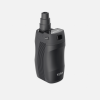Determination of Cannabinoid Vapor Pressures to Aid in Vapor Phase Detection of Intoxication
Tara M. Lovestead** and
Thomas J. Bruno
The quest for a reliable means to detect cannabis intoxication with a breathalyzer is ongoing. To design such a device, it is important to understand the fundamental thermodynamics of the compounds of interest. The vapor pressures of two important ...

www.ncbi.nlm.nih.gov
I read this article. It deals with vapor pressure, not
Determination of Cannabinoid Vapor Pressures to Aid in Vapor Phase Detection of Intoxication
Tara M. Lovestead** and
Thomas J. Bruno
The quest for a reliable means to detect cannabis intoxication with a breathalyzer is ongoing. To design such a device, it is important to understand the fundamental thermodynamics of the compounds of interest. The vapor pressures of two important ...

www.ncbi.nlm.nih.gov
I read this article. It is about vapor pressure, not boiling point which are two very different things.
While they are related, the vapor pressure of a compound is given as a pressure in a closed system. The BP is the temperature at which there is a phase change from liquid to gas.
The vapor pressure is the tendency of a substance to go from the liquid to gassous phase. There is an equilibrium between the liquid and the vapor at the service.
Vapor pressure increases with temperature. So, to determine the vapor pressure, you put the liquid in a container like a flask and hook it up to a manometer. This will give you a pressure at a specific temperature. By increasing the temperature, one can plot the vapor pressure points against temperature giving you a curve on a graph.
Unfortunately, this does not tell you at what point the substance boils.
Here is the problem. Every substance does not have a melting or boiling point. You could be in a lab and obtain a BP under vacuum. But as the pressure is increased, as one increases the temperature of the substance, say you start with a yellowish liquid. You try your experiment at half 1 atmosphere. The substance remains a liquid but turns black at a certain temperature before the BP. You lower the temperature and the substance stays black.
You run your new black substance through a GC/MS (gas chromatography mass spectrograph and lo and behold you now have a new substance that you can't identify!)
The intramolecular forces are too weak to take the heat so it degrades before boiling.
Kind of a paradox...
or bummer as far as THC is concerned.
I love organic chemistry.
The chemistry of compounds is facinating. How close 3,4,5 trimethoxyephedrine (phenylephrine) is to both ephedrine, amphetamine, and methamphetamine.
The difference between the first and last molecules are just the 3 methoxy groups!
It should come as no surprise that psuedophed is locked up at the pharmacy. We would not want people doing certain at home organic conversions now would we.
So, it should be no surprise, that the first molecule, mescaline, is pharmacologically a pressor and will increase BP and cause mydriasis, pupillary enlargement.
LSD is also related being lysergic acid diethylamide.
It too is an amide.
Of note, only the dextro isomers are generally psychoactive.








